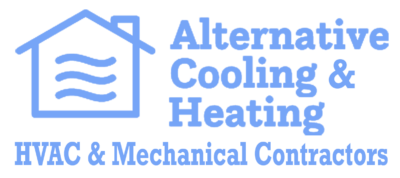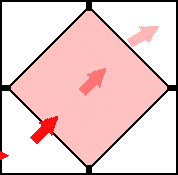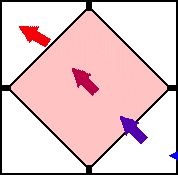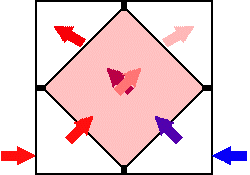Commercial/Residential Heat Recovery Ventilator
Alternative Cooling and Heating markets and manufactures a range of HRV’s for buildings of all sizes.
An HRV is a controlled ventilation system that reduces high humidity, pollutants and odors by replacing stale air with fresh warm air.
Exhaust air is not only stale and damp, but warm. It is this warmth that is used to pre-heat fresh air as it enters your home. All HRVs have two fans and an in-built “Air to Air” Heat Exchanger, which transfers heat from the exhaust air stream to the cold fresh air supply. By the natural laws of physics, whenever cold air is warmed, humidity is reduced, and condensation control is the result. The two air streams are 100% separated at all times. The fresh air introduced into your home is warm and dry and provides a permanently fresh, healthy, indoor environment.
An HRV can recover up to 5 times more energy than it costs to operate. This level of efficiency is unmatched by any other domestic appliance.
Unlike other condensation control devices, HRVs perform best, when conditions are at their worst. Sunshine, a warm roof space or heating elements, are unnecessary. HRVs ventilate, 24 hours a day, every day.
|
What an HRV System Will and Will Not do.
An HRV is a controlled ventilation system that recovers and recycles energy from an Exhaust Air Stream. In winter the HRV recovers heated energy, and in Summer, if your home is air conditioned, the HRV recovers cooled energy.
In simple terms, here is what the HRV can and cannot do ……
WINTER
Because most IAQ problems occur in winter, the HRV is ideal for NZ, because winter ventilation is an expensive in terms of energy waste.
The HRV is not a heater or a heat pump. It does not generate heat. It captures and recycles heat (or cooled energy) from other sources, eg …. log fires, gas heaters, electric heaters, heat pumps, hot water heaters & boilers, coal fires, under floor heating, ceiling heating, night store heaters etc. —– whatever the heat source, the HRV will recover the heat from the exhaust air stream and recycle this heat directly back into the home.
Whatever the source of heat in the home, if ventilation is required, this heat is wasted if ventilation is by opening windows or using exhaust fans.
The HRV captures and recycles heat that is contained in the polluted exhaust air, by using the heat to warm incoming fresh air. By the laws of physics, whenever air is warmed, its humidity is reduced, and so warm air can absorb moisture. Thus cold incoming outdoor air is “dehumidified”, when it is warmed by the re-cycled heat.
The HRV is a most effective method to control condensation, as well as providing a healthy environment, because the only air entering your home is Fresh Outdoor Air which has been warmed and dehumidified.
At the same time, humid warm indoor air, which has absorbed moisture, and contains other indoor air pollutants, is exhausted, and carries with it, the moisture and pollutants.
As the exhaust air passes through the HRV, the exhaust air heat is captured by the Heat Exchanger, and then directly heats the incoming outdoor cold air.
This is energy recycling in a very efficient manner. Effectively, the same heat is used over and over again. On a typical winter’s day in Hamilton, Wellington, Christchurch, Dunedin and similar environments the energy re-cycled is over 500% of the cost to run the two fans.
SUMMER — Air Conditioned Homes
In air conditioned homes, indoor air will be cooler than outdoor air, and the HRV recycles cooled energy, in exactly the same way as it recycles heat. ie the cooled energy is captured by the Heat Exchanger, and used to cool the warm outdoor air as it is introduced into the home, for ventilation. This reduces the “load” on the air conditioning system while providing 100% fresh air ventilation.
Most air conditioners simply recirculate, over and over, the same stale, and polluted indoor air, very few air conditioners have any provision to ventilate the air-conditioned space with fresh outdoor air. Thus most air-conditioned spaces in homes still require ventilation. The HRV saves summer “cooled energy”, just as it saves Winter “heat energy”
SUMMER — Non Air Conditioned Homes
The HRV can only dehumidify outdoor air (that is being supplied into the home) when the outdoor air is colder than the inside air. If the indoor air, is warmer than outdoor air, no dehumidification will occur. What does occur is that the HRV is an effective controlled ventilation system. It continuously exhausts indoor stale humid air and replaces this air with fresh outdoor air, which may be at the same temperature, as indoor air.
In some homes, even without air conditioning, it is possible for the indoor air temperature to be several degrees C, cooler than outdoors. In this condition, the HRV will cool the incoming fresh air, by recycling the “cool” energy that is retained indoors and using this energy to cool the outdoor air as it is introduced into the home.
If the outdoor air is warmer than indoors and humid, ie… a typical humid Auckland or Hamilton hot summer’s day. The HRV is a controlled ventilation system only. It will supply fresh outdoor air at whatever temperature and humidity the outdoor air may be. At the same time, it will exhaust warm, humid indoor air. The overall effect may not be very noticeable, but at all times the indoor air QUALITY is safe and healthy to breathe. In these conditions, normal indoor living activities will increase indoor humidity, and ventilation by the HRV with outdoor air that is slightly drier than indoor air will cause some dehumidification, but not significantly so.
The only practical way to dehumidify and cool a home in summer is to install a refrigerating air conditioner, and an HRV will continue to provide indoor air QUALITY while reducing the “cooling load” that the air conditioner has to handle.
Another way to appreciate what an HRV does and what it does not do, is to consider the conditions that are required indoors in a modern, well sealed, energy efficient, home, and the differences between Indoor Air QUALITY and Indoor Air COMFORT ie ……..
IN WINTER
The home needs heating — this is the function of a heating appliance, — to provide COMFORT.
The home needs a healthy indoor environment — this is the function of the HRV, — to provide Acceptable Indoor Air QUALITY.
IN SUMMER
The home needs a cooling effect, this is the function of an air conditioner, — to provide COMFORT.
The home still needs a healthy indoor environment — this is the function of the HRV, — to provide Acceptable Indoor Air QUALITY.
The keywords and differences are COMFORT and QUALITY. An HRV ensures QUALITY and it contributes towards COMFORT, but COMFORT is provided by specialized (Heating and Cooling) appliances.
HRVs provide Indoor Air QUALITY, summer and winter.
The rate of ventilation to provide indoor air QUALITY is the same, summer and winter.
The equipment required to provide COMFORT in winter and summer are vastly different.
The HRV is a “trickle ventilator”. The rate of ventilation will provide and contribute to indoor air COMFORT in summer, (particularly at night), but some homes are of a design that has massive summer “solar gain” on sunny summer days. The HRV will contribute to controlling summer solar heat gain, but do not expect the capacity of a basic HRV to perform the duties of a major ventilation or cooling system.
The HRV has some “spare ventilating capacity”. In summer this can be utilized by an optional outdoor sensing thermostat, so that on hot summer days, (say over 25°C) the outdoor thermostat switches the HRV fans to “high”, and so the ventilation rates increase to maximum. When the outdoor temperature reduces, (as in the evenings) the HRV fan speeds return to normal.
For homes that are closed up during hot summer days, even the “trickle ventilation ” rate of the HRV is very beneficial.
If your home has a summer solar heat gain problem, prepare a simple précis on the problems of the home, and what you want the HRV to do, with photos, plans, and a written description of what you perceive the problem to be, and forward to your Alternative Cooling and Heating dealer, we will be pleased to advise.
The most cost-effective approach is to eliminate as much solar gain as possible, — paint the roof white, install roof space ventilation, install sunshades to prevent heat from exposure entering the home, then evaluate and install whatever mechanical equipment is best to cure the problem.
An air conditioner to remove excessive solar heat gain from a home may need to be very large (capacity) and expensive.
We also manufacture, other forms of ventilation which can be installed in conjunction with an HRV. For example, the trickle ventilation rate of the HRV will ensure indoor air QUALITY is provided in both Summer and Winter, but on hot Summer days a home that suffers with too much solar gain, may need ventilation at 10 to 20 times the rate of an HRV to provide indoor COMFORT conditions.
It is common for us to manufacture, an HRV that has trickle rates of ventilation for most of the time, but for summer, (especially hot summer nights), a bypass damper causes the Heat Exchanger to be “bypassed” and for the ventilation rate to be increased 5 to 10 times, so that the home is ventilated as effectively as if all the windows were open (but in fact the windows are shut). These systems cost much less than an Air Conditioner and provide excellent results, but clearly, they are not as effective as a refrigerating air conditioner.
If you are considering an Air Conditioner, ask what provision it has to ensure that your home is ventilated with fresh outdoor air at the rate of .35 Air Changes per Hour, (Summer and Winter) as well as maintaining the indoor air conditions cool and dry.
For Summer ventilation applications we have a range of very large capacity (Supply & Exhaust) fans, that, when installed in our “Air Handlers” are ultra quiet, and can remove heat by automatically (with a thermostat) switching through three fan speeds depending on the actual solar heat gain of the day, as well as providing the benefits of an HRV in winter. To advise on these, we need plans & photos of your home, and a written description of problems and what results you expect.
This raises the question: We did not need special ventilation systems in older homes, why now, do we need a ventilation system to provide indoor air quality ???
Many older homes were built with high rates of natural air leakage that may have made the homes draughty, and difficult and expensive to heat, but the indoor air quality was provided by the rate of natural leakage.
Since the introduction of the 1992 Building Code, homes have to be energy efficient. The easiest way to achieve energy efficiency is to make the house as leak proof as possible. This is the cause of unhealthy IAQ. Older homes that have been “tightened up” by insulating, installing aluminum windows, and other draft reducing measures, have similar problems.
Modern lifestyles, and the need for security cause many homeowners to keep their homes as sealed from outside as possible, thus creating the problems of unhealthy IAQ.
Overall, the effect of making homes “tighter” is to cause Indoor Air QUALITY problems.
The best solution is controlled ventilation, and dehumidification with energy recovery — an HRV.
SUMMARY
An HRV is most effective as a Winter ventilation system to …….
Dehumidify and ventilate with 100% fresh outdoor air and to maintain INDOOR AIR QUALITY.
In Summer, the HRV will maintain Indoor Air QUALITY, and it will contribute to improving Indoor Air COMFORT, but if the home suffers from excessive heat gain from sunshine on hot summer days, the HRV may not have sufficient capacity provide Indoor COMFORT.
The HRV cannot dehumidify outdoor air when the outdoor air is warmer than indoor air, in these conditions it is a controlled ventilation system that supplies air to, and exhausts air from, the home.




